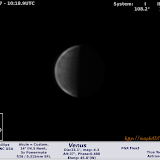Spanning from January 4th to December 30th (Never give up!), all photos are mine, including the Earth and all taken within the calendar year of 2014.
While last year was the year of the comet with 4, this was the year of the asteroid for me with over 12. I say over 12 because as I learned to hunt these tiny and faint things amidst the stars I found some images of poor quality and sometimes iffy results.
Here's the high resolution version on imgur as google shrinks it.
Here's the high res version with labels on imgur
Sun - 20141021
Sunspot map from the same day: http://www.spaceweather.com/images2014/21oct14/hmi1898.gif?PHPSESSID=117sfv869vda0snais43gtol01
My other solar photos here
 |
| Solar |
Earth via my amateur nature collection
 |
| Nature |
 |
| Nature |
 |
| Nature |
Lunar Eclipse - 20141008
 |
| Lunar Eclipse 2014 |
Mars - 20140327
This image was featured on the Spaceweather!
 |
| Mars 2013-2014 |
Asteroids and minor planets
This year was the year of the asteroid as I got my MPC site designation by observing 3 asteroids in one field of view over 3 nights!
My work in progress table
 |
| Asteroids |
This image was Published in Sky & Telescope April 2014
 |
| Jupiter 2013 |
 |
| Saturn 2014 |
I also made a moon animation! http://astromaphilli14.blogspot.com/2014/09/uranus-and-5-moon-animation.html
 |
| Solar System - Uranus - All years |
 |
| Neptune All Years |
MISSING from 2014 are:
Mercury |
| 1-Mercury |
 |
| Astronomy / Solar System / Venus / All years |
Finally
If you enjoyed this post please check out my other work on my homepage:
http://maphilli14.webs.com/
Also check out previous years 'best of':
http://maphilli14.webs.com/solarsystemreviews.htm
Subscribe to my social media
Mike Phillips

Create Your Badge
Follow @maphilli14





























